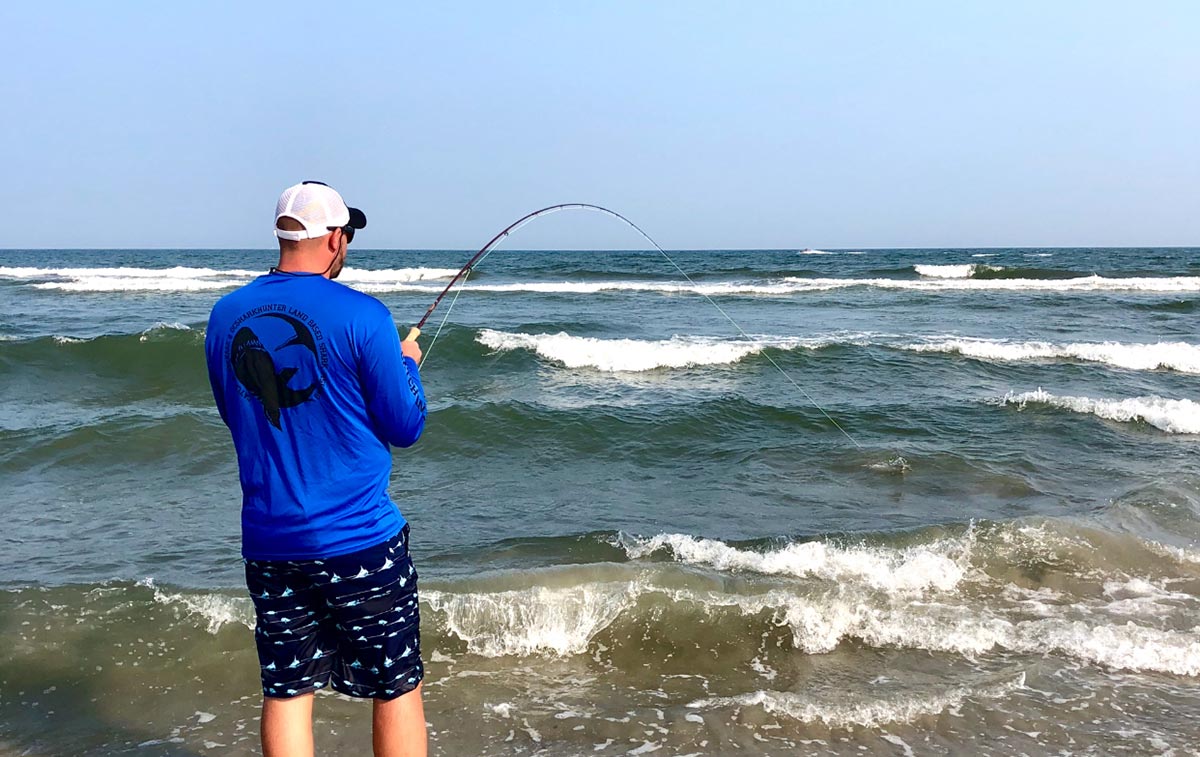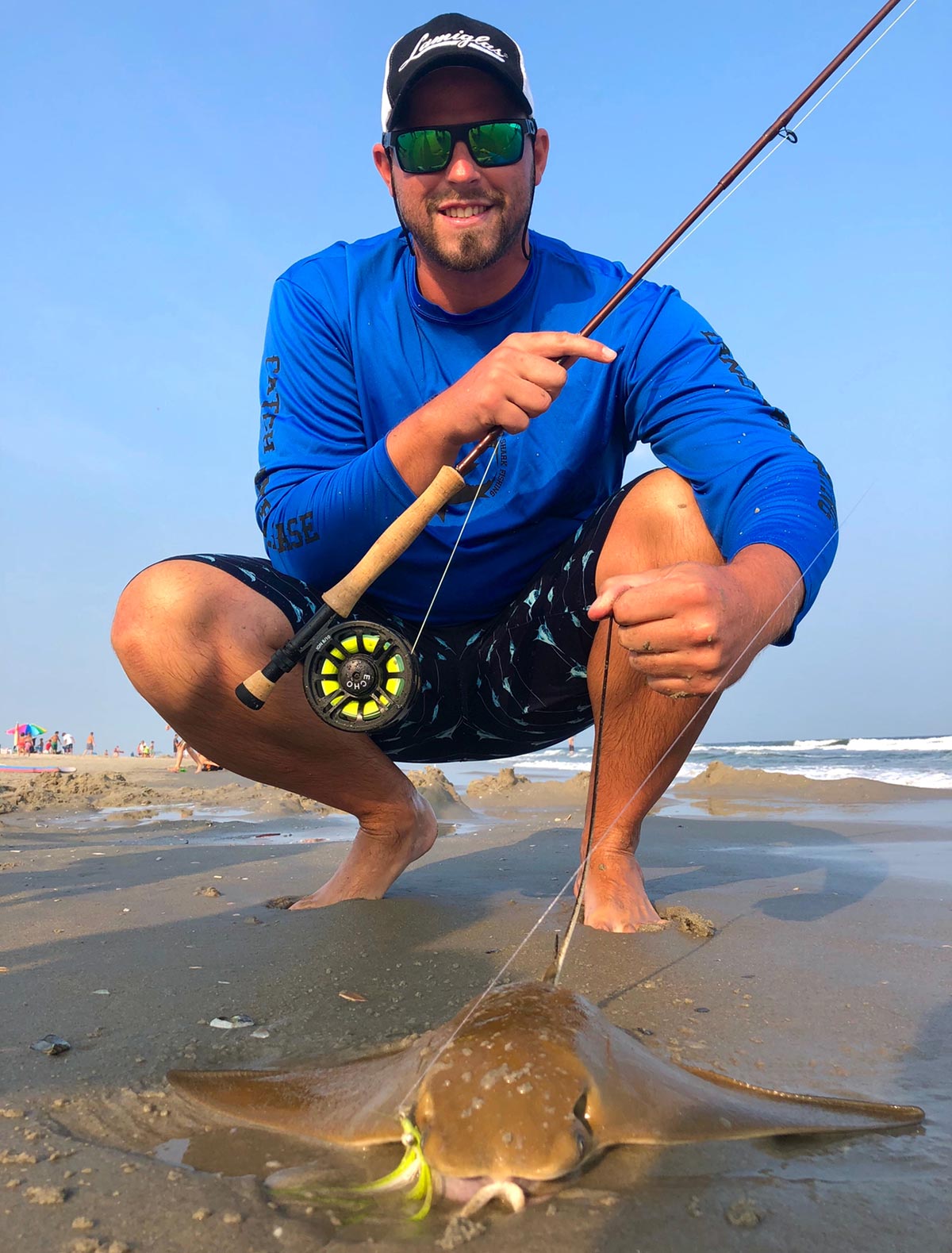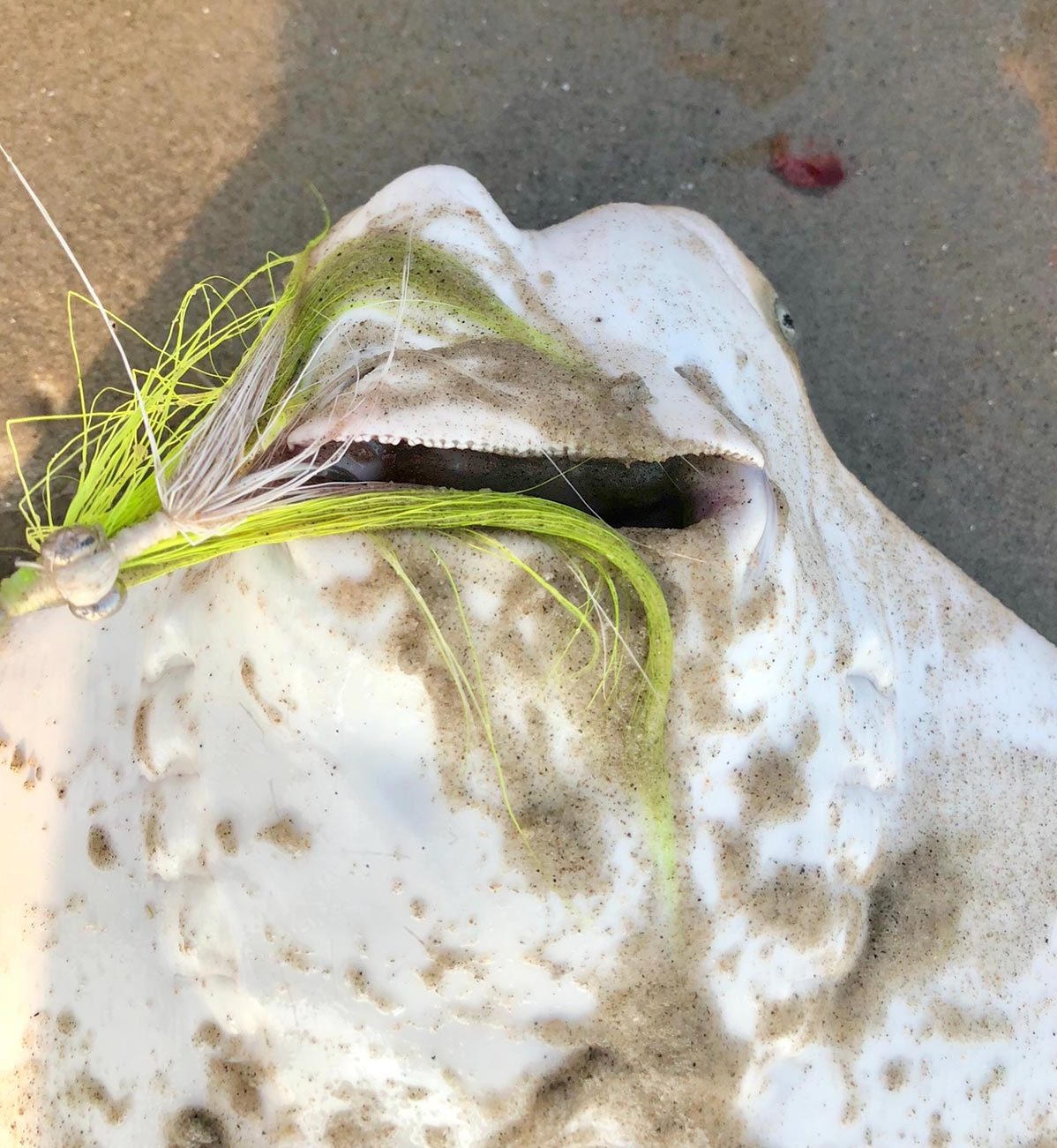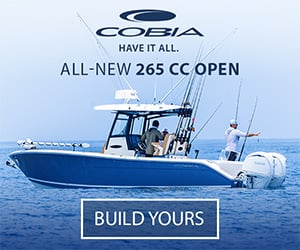
Some folks pull their casts to avoid the rays, while flycasters see a challenging new taker in the surf.
A big part of the reason that an angler is drawn to the sport of fishing is fighting a fish. The harder the fight, the more fun it is. Fly fishing in the salt gives you that chance more so than most other types of fishing.
This is one of the main reasons I chose to get into fly fishing. A new challenge and a chance to catch fish with an incredible fight. Fly fishing in saltwater is a whole new ballgame, but don’t let that scare you into not giving it a try if you haven’t before. In a summer where clean water has been pushed into the surf for a few months, tons of bait and bigger predators have been showing up and are easily visible from dry sand. Recently I had an idea while shark fishing on the beach and noticed schools of cownose rays cruising the shallow surf and riding in some waves in a deep cut right up against the waterline.
How crazy would I have to be to try to catch one of these on an 8-weight fly rod? Can it be done? Is it even possible from land? It’s possibly very crazy but I had a good feeling about it.
Catch Some Rays

I am a huge proponent of opportunistic fishing. So if something presents itself that may intrigue me, I will most likely give it a shot. Trial and error is a great way of learning new things. These rays normally only feed on oysters, clams, and other mollusks so I knew it wouldn’t be too simple of a task. I had in mind that with so many around, there had to be at least a few that might want a bait-like fly.
I had a clear beach on both sides of me and could walk it down the beach if I were to hook up and need to walk it up or down the beach. I have heard of them being caught on lures and have caught plenty on chunk baits but I hadn’t heard of it being done or attempted to throw flies and catch them that way.
One of my favorite parts of sight casting for fish is that you can see the action happening right in front of you. Most times you only need to wade into the water a foot or so, depending on if you need more room for your back cast. One thing I have found pretty useful on a beach in summer is walking into about knee or thigh deep water and casting on different angles to keep your back cast out over the water. Try to make your casts well ahead of the direction the school is swimming and make shorter and quicker strips to give it some good action and lifelike movements. They tend to be higher in the water column, so when in a few feet of water keep this in mind when you guide your fly through the surf. The water temperatures that I have seen and caught them was in the low to mid 70s. Cownose rays usually show up in the middle to late summer on the Jersey coast. You can find them in big schools or just a handful together.
If you are barefooted (which is very likely in late summer), just be aware of your surroundings as some of these rays won’t hesitate to come explore right up to you and behind you in super shallow water. I have stepped on them quite a few times when there are so many around. Cownose rays are fairly docile rays but they do have a short venomous barb on the top of their tail where it joins to their body. You are much more likely to be pinched by a crab, but be cautious and keep this in mind after you land one and are removing the hook, especially with larger rays (They will have bigger barbs.). Pliers are recommended.
Flies & Tackle
A key to targeting any species is knowing what types of bait are around and the profiles of the bait as well. By late summer, spot are starting to show up. Spearing, anchovies and others similar small baitfish are also seen in the wash. So the key is to find something that these cownose rays could possibly be feeding on and might inhale one of your flies.

One of my go to flies when feeling out an area is the Clouser Minnow. A Lefty’s Deceiver or a Glass Minnow would also do the trick in shallow surf where these baitfish patterns mimic what these rays may be feeding on. I tend to choose white and bright colors as my first preference. All of the rays I landed came on a white and chartreuse Clouser. Strong hooks are a key when fishing saltwater flies. The size of the hooks depend on the size of the fish you are targeting.
An 8-weight St. Croix Imperial rod that I have for fishing back bay stripers is what I chose to target some smaller size rays in the 10- to 15-pound range. Anything larger than that I would move to a 10- to 12-weight range as these rays tend to be pretty thick and can get up to over 35 pounds and close to 30 inches wide. The 8-weight rod I used was a 9-footer with nice action on it. The 9-foot rod allows you plenty of distance for casting, although this is sometimes not even necessary due to the cownose rays coming to the white water in the surf.
I chose an 8-10 weight Echo Ion reel to pair up with my 8-weight St Croix rod. A good drag system is more important when targeting species that tend to run; all of the rays that were landed got to the fly line within seconds and started taking drag. While casting I like to have a loose drag, making it easier to false cast and cast farther and farther. Once a fish is hooked up, you can use your hand as a drag until your stripped line is gone. Then you can tighten your drag to whatever you deem necessary.
An 8-weight forward cool water fly line from Rio is a good spot when choosing your line. As stated earlier, cownose rays usually feed higher in the water column so a sinking line isn’t necessary, but it will do just fine if you are fishing in only a few feet of water. I tend to use a 4- to 5-foot leader as my tippet made with Seaguar 20-pound fluorocarbon. This covers a wide variety of saltwater fish you may target with flies. The reel is backed with 30-pound Dacron backing.
One thing to keep in mind when tying flies onto your leader; keep the tie ends of your knot short to keep your leader as long as possible and last longer as well.
| SALT SENSE |
|---|
|
Sunglasses are one of the most underrated part of fishing and especially sightcasting. Polarized lenses will allow you to gain another edge and help immensely to increase sight into the water. My Costa Motu green 580 polarized lenses are the first thing I grab even before any rods or reels. After any trip to fish in saltwater I’d recommend a light hose down of all your gear. This will wash the salt off and keep your gear top shape as long as possible. Some hooks will tend to rust if they aren’t rinsed with freshwater. – L.W. |



